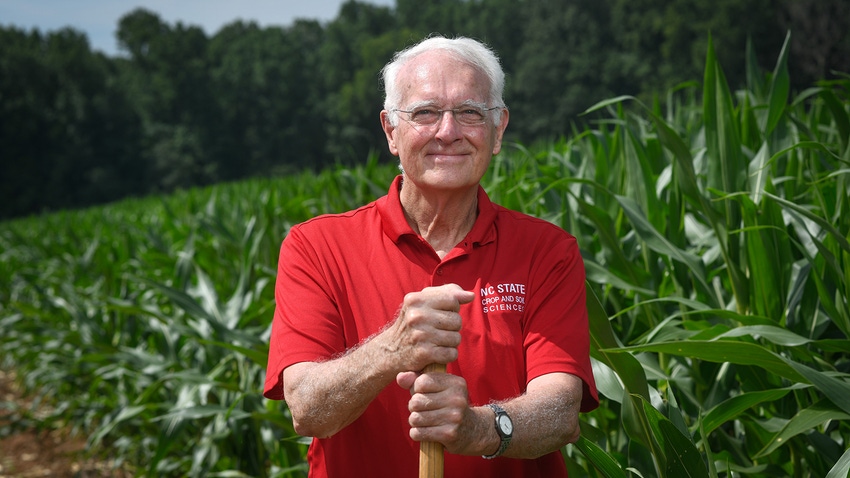
Chances are excellent that many of the crop consultants attending the fall conference of the North Carolina Agricultural Consultants Association in Raleigh Dec. 9 were students of Bob Patterson at North Carolina State University. Patterson has taught at NCSU since 1968 and is well known for the profound impact he has had on generations of students in his 53 years of teaching.
At the consultants’ conference, Patterson, an expert on soybean physiology, provided a refresher course on the agronomics of soybeans and offered pointers on producing the best crop possible.
Patterson stressed it all boils down to using a diversity of agronomic production decisions, with selecting the right maturity date, the right planting date and foliar fungicide use among the most important factors.
In preparing his comments to the consultants, Patterson first consulted Rachel Vann, North Carolina State Extension soybean specialist, in both personal conversation and the study of several recent publications written by Vann and several of her departmental colleagues, including her graduate students, to confirm the major points the consultants would benefit from hearing.
Patterson also turned to retired North Carolina State Extension Soybean Specialist Jim Dunphy who stressed to Patterson that whatever you do to a soybean crop, if you can cause it to lap in the middle by the R1 growth stage, and you see that first flower in the mid-point of the main stem, that means you have done a lot right.
“The data I have seen in the last few years of publication, from our Extension specialists and also from the plant breeders, is that the yield advantage is greatest for maturity Groups IV or earlier. An earlier than May 12 planting generally provided more yield benefit when earlier maturing varieties were used,” Patterson said.
Patterson noted there is great interest now in early maturing varieties in North Carolina due to higher yield potential, a premium for early delivery and the possibility of harvest prior to damaging fall weather. He said the potential conflicts for early maturing varieties include inadequate disease resistance, including nematodes.
“Current early maturing varieties have primarily been bred for places other than North Carolina; there could be seed quality issues relating from high heat and humidity and rainfall during late seed development. There are harvest conflicts with other crops in the rotation and the necessity for more intensive management to capitalize on potential yield benefits,” he said.
Early maturing varieties had a lower protein content in general than later maturing varieties. Oil content, including oleic, on the other hand, was greater for the early maturing groups. “It is an inverse relationship compared to protein content,” Patterson said.
When it comes to seeding rates, Patterson noted recent research by North Carolina State University indicates that as seeding rate is increased, yield typically increases and then stabilizes at rates greater than 100,000 seeds per acre for both maturity Groups III and IV.
Patterson noted that North Carolina State’s current seeding rate recommendations for primarily determinant varieties are 50,000, 70,000, and 100,000 plants per acre for May, June, and July planting, respectively.
“Row spacing can have a huge impact on yield, but apparently not so much on quality. The yield advantage of narrow row spacing, typically, is more pronounced in the high yield environments. We are talking about 15-inch rows versus 30-inch or 36-inch row widths,” Patterson said.
One thing is certain, Patterson relished the opportunity to reconnect with former students at the consultants’ conference while the consultants valued the opportunity to learn from a favorite professor once again. Patterson has received more than 66 research and teaching awards while at North Carolina State. He currently serves as Alumni Distinguished Professor of Crop Science.
At age 82, Patterson is recognized as one of the most respected and popular professors at North Carolina State University. He became a freshman at North Carolina State in 1957 where he earned his bachelor’s and master’s degrees in soil science. He earned his Ph.D. in agronomy from Cornell University in 1968.
In an email, Patterson noted that speaking at the consultants’ meeting was “such a satisfying experience, being able to interact in such splendid ways with many of my former students, and to learn more about their most impressive professional involvement in North Carolina agriculture, in support of both producers and consumers of our crop production initiatives.”
“What a blessing for our state’s crop producers to have such ready access to strongly motivated and knowledgeable crop consultants, who clearly care for our state's agricultural progress in the best of ways,” Patterson wrote in his email.
About the Author(s)
You May Also Like






